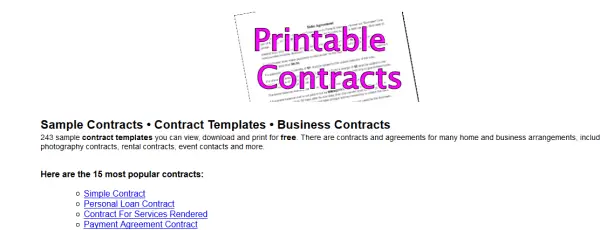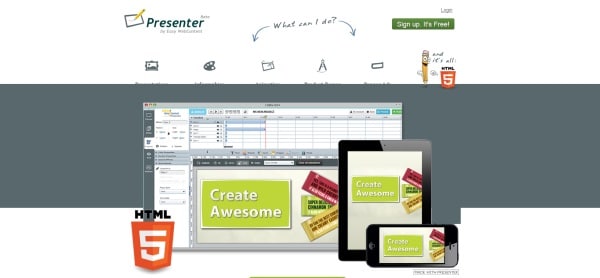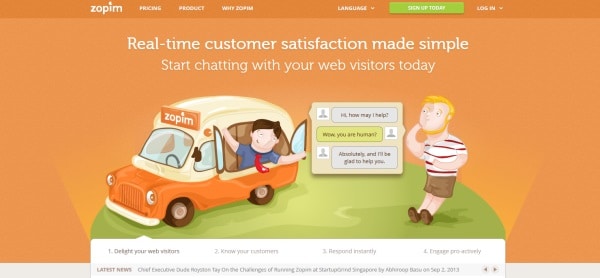Even though the most important (and the core) activity that web designers are paid for is obviously designing itself, a total of zero design-related mistakes have made this list. How is that even possible?
Well, first of all, who am I to say that my design practices are better than yours? But even more importantly, working with clients requires more skills than just a good feel for up-to-date design.
Not having a quality contract
Let’s start the list with one of the most neglected elements of a designer-client cooperation.
Back when I was running a web design business, in its early stage, we didn’t pay much attention to contracts and other legal aspects of our work. The main problem with such an attitude was that every now and then a client didn’t have money to pay us in time. This is a serious issue even if you’re just a solo-entrepreneur, but if you have a business and two other people on the payroll then it quickly goes from serious to incredibly serious.
Now, I know that you can’t really do anything if someone doesn’t have money to pay you, but you can do a number of things to prevent such a situation.
For instance, the rule that we implemented later on was to get half of the money up front. This was proof that the client was serious and that they had money to do business with us. One more benefit (although some might call it a downside) of using this method is that it weeds out clients in bad financial condition right from the get-go.
Having a quality contract protects you from a number of other issues apart from the financial stuff. In other words, if you want to invest in some business development asset then start with a quality template contract tailored just for you.
If you don’t have the budget to hire a professional at the moment, then go to a site like printablecontracts.com and browse the archive to find a “good enough” contract to start with.

Not providing support
Apart from your hosting provider offering customer support, I believe that you should do it too, at least to some extent.
Modern websites are not much different from other software. And like other software, sometimes they stop working for one reason or the other. Most of the time, the problem lies somewhere on the hosting side but not always. This is where you come into play.
By offering one year of free support, you’re making your clients feel confident. You are conveying an important message that you care about the performance of the websites you create.
The benefits for your clients are pretty straightforward – it’s just good service. But the most significant benefit for you is that the clients are more likely to come back with new projects in the future.
In short, the quality of post-delivery service really does matter in web design.
Not realizing specific content needs
Depending on each individual project, your clients may end up publishing some types of content more often than others and it’s your job to find out what that might be.
It’s a wild guess, but I think that more than 90% of all websites are capable of hosting and showcasing text content effectively. However, text isn’t the only type of content being published on websites these days.
Even though I’m sure you know this, it’s actually very easy to overlook this fact when working with a client.
For instance, the display area needs to be wide enough if it is meant to feature video streams at any point in time. Also, assign much white space around image galleries and other forms of visual media. And if your client plans to host any form of audio content then you should provide custom elements to present transcripts and TOCs too.
These are just some examples and I’m mentioning them to guide your attention towards any individual needs that are tightly connected to the various content types.
Not using external content tools
The idea of designing websites with WordPress plugins in mind is pretty well-known. In other words, whenever you have the chance, you should use an existing plugin to provide a given functionality, rather than implementing it yourself from scratch. But I actually want to take this a bit further.
Except WordPress plugins, you can take an even broader look on what’s available. Use other external tools and then display the output they produce on the site. The things that come to mind right away are:
- Presenter – a tool for creating visually attractive animations, presentations and all sorts of interactive content through an easy-to-use interface. The best thing is that Presenter produces an HTML5 output, so you don’t have to worry about any incompatibility when integrating it with WordPress.

- MailChimp – an email newsletter service. Although there is a handful of newsletter plugins available for WordPress, you will still get a better effect with MailChimp (functionality-wise), which will also deliver better service to your client. Showing MailChimp’s subscription forms on WordPress is also hassle-free.
- Zopim – a great online chat tool. It integrates with any website to provide a very well-designed and sufficiently functional chat box.

This is just the tip of the iceberg, though. I encourage you to do some researching of your own and find more tools just like these.
Not partnering with your peers
Networking and making new contacts is probably one of the best business practices every entrepreneur can do. Let me give you an example. If you’re a web designer and design is the one thing you do then consider teaming up with other professionals in some side niches like: SEO specialists, social media managers, article writers, marketing specialists and so on.
The idea is to refer your clients to other people who can provide them with quality service. That way, in return, you are sure to get some referrals as well.
You can search for quality contacts on sites like LinkedIn or even Google. If you’re a solo-entrepreneur then try searching for solo-entrepreneurs too. Big firms are less likely to get into any form of agreement with you on this.
Not upselling on cheap things
Lastly, I want to talk about upsells. The idea is quite simple and it’s basically about offering additional products or small services for a very small fee.
Upselling is done when the initial deal has been set and the client has agreed to begin their project with you. This moment – right after the client said yes – is perfect for offering some additional services that aren’t expensive, but are still attractive for this specific client. This is simple freelance marketing 101.
For a web designer, these can be things like: setting up social media accounts, designing a Twitter background, preparing social media avatars, setting up whole Twitter accounts and building Twitter relationships, publishing some initial core content on the website (the content your client sends) or setting up a Dropbox account for website backups. There’s really a vast number of possibilities.
The main reason why I advise you to do this is because, at first sight, you are not any different from other designers in your client’s eyes. So by offering something additional that’s a nice touch, you’re simply standing out from the crowd.
What’s your opinion about the above list? Also, are there any more web design client mistakes you want to add?
About the author
Karol K. is a freelance blogger and writer. He is founder of newInternetOrder.com, and he also likes to blog about WordPress and how easy it is to launch a site with it. If you’d like to get in touch, feel free to reach him at Google+ or Twitter (@carlosinho).
The post 6 Web Design Client Mistakes You Are Probably Making appeared first on Design Inspiration | How to Design a Website.
via http://feedproxy.google.com/~r/LearnWebdesign/~3/kq5xlU3mNeA/web-design-client-mistakes

No comments:
Post a Comment